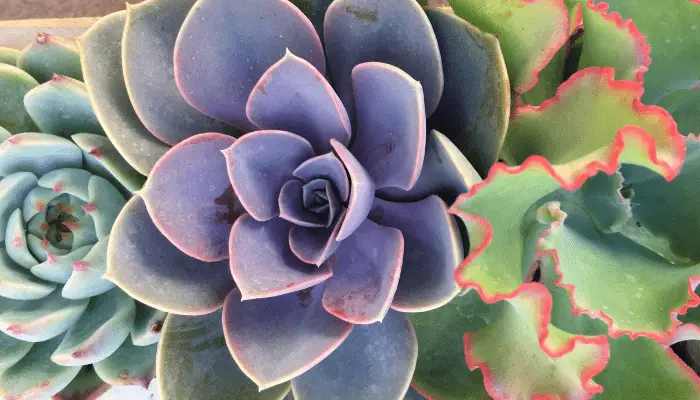If your succulent is turning purple, it’s usually because it is going through some type of stress and releasing a pigment, such as anthocyanin. Succulents can become stressed and turn purple (or some other color) when they are over-watered or under-watered, exposed to too much or too little sunshine, given the wrong type of soil, or exposed to temperatures that are too hot or too cold.

As you may already know, succulents are a hassle-free plant that doesn’t require a lot of maintenance, unlike many other types of plants.
However, that doesn’t mean they are totally care-free and don’t require proper attention or care.
In fact, one of the major reasons succulents turn purple is from over or under care.
For example, giving your succulent too much or too little water.
So, if you do find yourself wondering, ‘why is my succulent turning purple?’, it is probably because of factors such as low or high exposure to sunlight, cold temperature, change in environment, soil, or watering problems.
Table of Contents
Why Do Succulents Turn Purple?
Before we talk about the reason, it is essential to try and understand why your succulent might be changing color.
Essentially, It is because they are going through some type of stress.
And this stress can be due to a number of environmental factors.
When succulents get stressed, they release pigments, such as anthocyanin.
Due to the release of anthocyanin, your succulent may turn blue or purple.
But they may also turn red or yellow due to the release of carotenoids.
The Main Reasons Why Succulents Turn Purple
There are some specific reasons why your succulent might be turning purple, such as:
1. Normal Changes
Keep in mind that there are certain succulent plants, such as hens and chicks succulents, that naturally change the color of the leaf tips to purple.
Moreover, if you don’t find any other distress symptoms, such as slow growth, or a wilted or shriveled appearance, then you may not have to worry about the change in color.
2. Overwatering Your Succulent
Sometimes, overcaring may also lead to the purpling of your succulent.
So, when you overwater it, it may release anthocyanins.
Make sure that you lookout for signs of overwatering, such as:
- Discolored and curled leaves.
- Shriveling stem and leaves.
- Loss of color and vibrancy.
- Shedding of leaves and other branches.
- Dry soil.
If you notice these signs, you may want to cut back on watering.
3. Underwatering Your Succulent
Just like overwatering, underwatering your succulent may also make it distressed.
A good way to check if the soil is damp or not is to make use of a soil moisture meter.
This way you will know whether your plant is underwatered or not.
If you realize that it is, you’ll need to start watering it a little more.
4. Over or Under Exposure to Sunlight
Just like any other plant, your succulent also requires a specific amount of sunlight.
So, it is important that you keep them in direct and indirect sunlight for the amount of time your specific species requires.
Keep in mind that over-exposure to sunlight may also lead to the release of anthocyanins.
Above are some of the most common reasons for a succulent turning purple.
Some others may also include soil-related or temperature-related issues.
How to Stop Your Succulent From Turning Purple?
Once you know the reason why your succulent is changing color, it’s usually not too difficult to halt the process.
Here are a few common fixes:
1. Give Proper Sunlight
It is essential that you give the right amount of sunlight exposure to your succulent as they are mostly desert plants.
You may also need to ensure that you give ‘indirect sunlight’ and not total or full sunlight exposure as that may lead to over-exposure.
Take the time to research the specific needs of the plant you are caring for.
2. Provide the Correct Temperature
Anthocyanins are released during temperature stresses too.
So it’s also necessary that you provide the correct temperature for your succulent.
The ideal temperature for a succulent plant usually ranges from about 12 to 25 degrees Celsius (or 53.6 to 77 degrees Fahrenheit).
It is also important that you don’t expose them to extremely hot or cold temperatures.
3. Proper Soil Composition
All succulents require proper cactus mix soil if they are to thrive.
For this type of soil, you can pick up a ready-made one from the store.
If you want to make one of your own, you can add in the same amounts of potting soil mixed with coarse sand, pebbles, pumice, and volcanic rocks.
Just don’t go for plain old garden soil.
4. Proper Watering
Lastly, make sure you water your succulents properly.
To achieve this, you only need to water them when the soil looks completely dried up.
Moreover, once you do water them, continue doing so till the water finally comes out of the drainage holes.
Final Thoughts
If you do find that your succulent is turning purple, try out a few of these quick fixes and there’s every chance you’ll get your succulent back to being a thriving plant once again.




